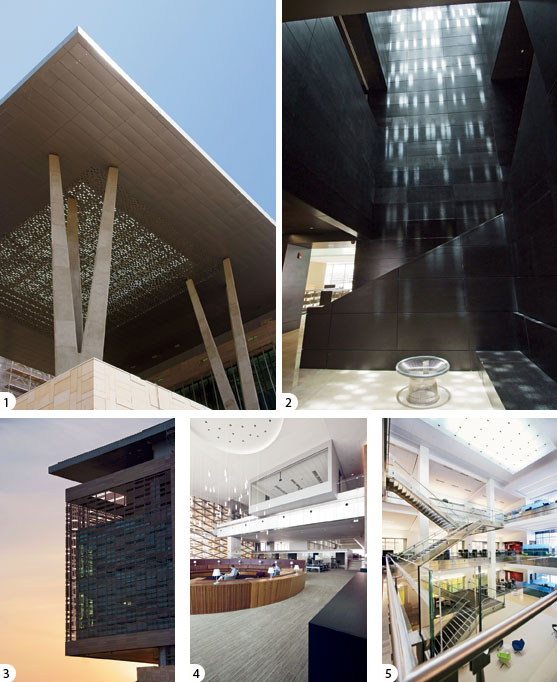KAUST
 |
1. A large roof supported by treelike columns shades the plaza leading into the pedestrian spine. KAUST's roof system alludes to Bedouin tent design by blocking out the intense sun and encouraging airflow. Photos: © JB Picoulet |
Â
At the heart of the campus, around the main quad, are conventional academic buildings, including classroom and administrative buildings, an auditorium, and a conference center. The rotunda - a tall, oval-shaped, glazed exhibition space supported by diagrid steel bracing - represents one of the campus's special objects, along with the stone-glass-clad library and a pair of slender, rectangular solar towers. A diagrid structure, not always steel, became a unifying strategy for these unique elements. Other such elements, like the entry pavilions for the pedestrian spine, feature lofty roofs and treelike columns to express its singularity.
While KAUST's campus design shares much in common with American universities, familiar to many of Aramco's employees who studied in the United States, the contemporary campus aesthetic is grounded in historical building precedent. HOK looked to the compressed buildings and covered spaces of traditional Middle Eastern cities when laying out the campus and designing its features, creating closely knit buildings with protective roofs, or, as HOK refers to it, a singular megabuilding linked by a number of interior and exterior courtyards, improving proximities among researchers, faculty, and students in the hot and humid climate.
Based on energy modeling HOK conducted with environmental consultants RWDI, it determined that this approach, which minimized the amount of exterior envelope exposed to the sun, would result in an approximate 10 to 15 percent decrease in energy use compared to a layout in which buildings were spread out and exposed on all sides. Building orientations also limit harsh eastern and western sun exposure while taking advantage of prevailing Red Sea winds to act as a cooling mechanism.
Like a traditional souk, or market, the layout also promotes greater social activity by providing a shaded pedestrian zone. This active outdoor concourse houses conference, meeting, office, and retail space while bisecting and interconnecting all research buildings. HOK designed the pedestrian area to be accessible not only to wheelchairs and carriages, but to Segways - an increasingly popular method of getting around campus, and to and from the residential areas less than a mile away.









